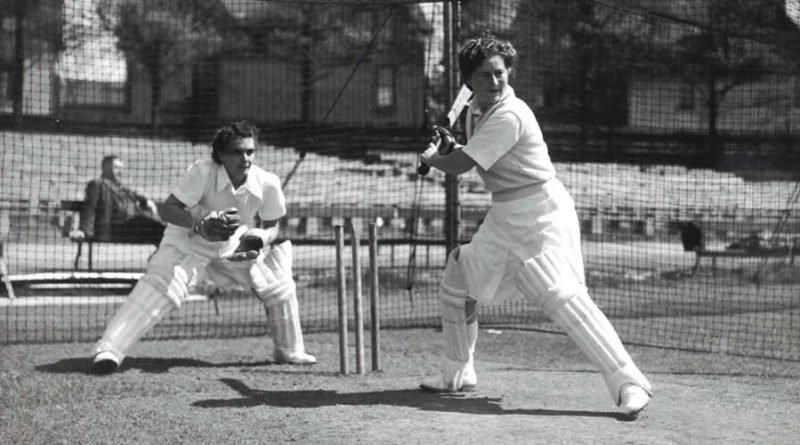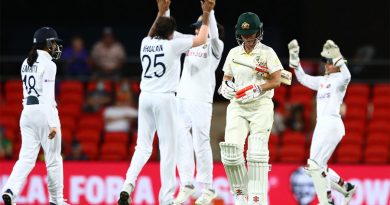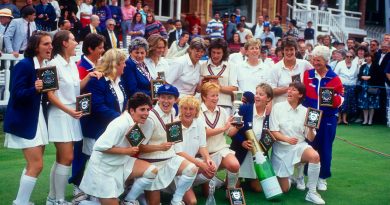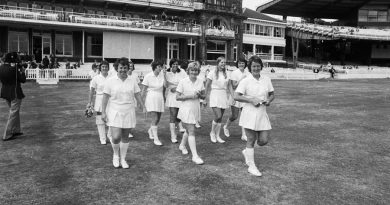Stoic Opener: Mary Allitt
Born on November 1st 1925, in Deniliquin, New South Wales, former Australian Test cricket captain, Mary Allitt. Mary was the fifth captain, following on from Muriel Picton.
If Mary’s parents had intended to create an entire cricket team from one family, they well and truly succeeded, for with her seven brothers and three sisters, Mary and her siblings were their own cricket team. The family farm at Camperdown, Deniliquin would have hosted many a “Test” match.
Growing up on a large family farm, Mary and her siblings pitched in with the chores, as was common for all country children of the time. (Plenty of help with eleven of them!) It was a mixed farm that dabbled in rice cultivation and horse breeding. Aside from her cricketing prowess, Mary Allitt became a fine horse rider and took a keen interest in show riding. She was adept at a number of other sports, including golf, softball and basketball.
Deniliquin
Deniliquin is a small country town in the Riverina district of NSW and has a history of merino sheep breeding and rice cultivation dating back to the mid 19th century. On the 1934/35 tour by England under Betty Archdale the small town was on the tourist’s playing schedule and so too in 1948/49 when Molly Hide brought her team to Deniliquin, some 24 hours by train from Sydney, they played a single innings match against the locals at Memorial Park.
Molly Hide had match day off and Myrtle Maclagan took over the captaincy, lost the toss and Deniliquin batted first on the only matting wicket the English would encounter for the whole tour. Not only was the pitch a little primitive, but so too the ground itself, a classic Australian country ground with bindis, and holes. The outfield was a mixture of sand, gravel and wafting tufts of weeds.
The conditions made it difficult and uncomfortable for the England team in the 100 degree heat, especially when you consider their attire.
“Cover point, in these circumstances, spends much of the forenoon picking tickly black grass seeds out of her white stockings!” – Nancy Joy, “Maiden Over”
Making the task of fielding more arduous, was the Deniliquin, team’s opener, 23 year old Mary Allitt who all but carried her bat making 51 out of the team total of 96.
Three of Mary’s sisters, Joyce, Heather and Gwen were also in the team, making four Allitts in total. Second top score was sundries with 17, followed by the only other double figure score, Joyce Allitt with 12. England won the match easily by nine wickets but they’d have done well to remember the young opener who steadfastly resisted an international bowling attack for nearly three hours.
Training with the men in Deniliquin, due to the lack of a women’s team, Mary first came to the NSW selectors notice in 1947 and earned a place in the NSW Second XI. The following season she was selected for NSW.
Selection for NSW
In that 1948/49 home Ashes series, Molly Hide’s England team played a NSW team with Mary Allitt scoring 2 runs opening the batting with Test veteran Amy Hudson in the first innings, and 14 opening with Lorna Thomas in the second innings. Hardly a match winner, but she was solid in both innings and proved difficult to budge.
Following continued good performances at the top of the order for NSW over the ensuing seasons, Mary gained a good reputation as a solid and reliable opener and was selected in Mollie Dive’s team to tour England in 1951.
England Tour 1951
A solid 42 against Yorkshire and a quick-fire 80 against Northern Counties saw the young opener hit her straps and settle into the English conditions. Another timely half century (82) against Warwickshire and Nottinghamshire just prior to the first Test at Scarborough, saw Mary Allitt selected for the Test team.
It would have been a comfort going into that Test with her NSW state captain, Mollie Dive, and NSW opening partner, Amy Hudson plus NSW fast bowler, Norma Whiteman. Some familiar faces at least – the rest of the Test team were all from Victoria. In the drawn Test match, Mary scored 30 and 8.
In the low scoring second Test, played at Worcester, Allitt struggled against Mary Duggan and Myrtle Maclagan with scores of just 2 and 13, but personal scores are of little value when you’ve played in a winning Test match. From a batting perspective, Allitt again underperformed in third Test at the Oval, as did the rest of the Australian team, going down against Mary Duggan’s bowling in England’s victory. Despite the modest returns in the Test matches Mary’s overall tour numbers were good.
Test Cricket Drought
Good form for NSW over the following years during the Test match drought of the early 1950’s saw Allitt turn out in Una Paisley’s team for the one off Test against New Zealand in Adelaide in 1956/57. Australia won by an innings, but after waiting for five years to play her next Test match, Mary managed just the one run. It was a similar tale with the bat against England in 1957/58.
Three seasons passed before another Test match was played, in 1960/61 against New Zealand. The young NSW allrounder Muriel Picton was given the reins, with view to her captaining the team to England in 1963. Mary’s form was still modest at best in the Test team with 31 and 2.
When the team was selected for the 1963 tour to England, the selectors, one of whom was Mary Allitt, had a change of heart. The incumbent, Muriel Picton, would be relegated to the vice-captaincy and Mary Allitt became Australia’s fifth Test captain.
It might be easy to conclude that Mary got the captaincy on account of her position as selector, but one must remember that there were two other selectors at the table. Perhaps the biggest clincher of all was the fact that Mary was the only player in the entire squad who had toured England before, when she had been a part of Mollie Dive’s 1951 team some twelve years earlier. Not one of the other 1963 tourists had ever played in English conditions. Surely this must have been uppermost in the minds of the selectors.
England Tour 1963
“The team had a very gay send off. Molly Dive, Amy Hudson, Margaret Peden, Nell McLarty, Joan Schmidt, Myrtle Bayliss all came to say goodbye.” – Lorna Thomas
On balance it was a solid team, albeit one of greenhorns, yet the experience of Mary Allitt and the guiding hand of team Manageress, Lorna Thomas would help the young tourists gel.
A converted 41 seat coach was the team’s transport for the tour. Half of the seats were removed and tables installed. A bench was fitted at the back as part of a makeshift kitchen, complete with crockery and an urn.
The cricket began on the 21st May against a West XI in Torquay. As if to prove that her knowledge of English conditions was a handy asset, Allitt scored 118 not out.
First Test, Edgbaston, Birmingham
The first Test was played over three days at Edgbaston, on 15th, 17th and 18th June 1963. The first morning, a Saturday, was crisp, yet bright and sunny and the teams were introduced to Dr. Glass, the Lord Mayor of Birmingham and the Lady Mayoress, Mrs. Glass, before a crowd of about 2,000 spectators.
Mary Duggan had been England’s captain since the 1957/58 tour of Australia and New Zealand and boasted a team with a strong batting lineup with regular openers, Cecelia Robinson and Shirley Driscoll and talented new kid on the block, Rachael Heyhoe. The team had also toured South Africa in 1960/61, without Duggan, but it all pointed to an outfit that was more than ready for the Australians, despite having five debutants.
Mary Allitt got her captaincy off to a good start, winning the toss and choosing to bat on what looked like a good batting strip. She was joined by Lyn Denholm, as the Aussie openers took guard.
Mary Pilling and Dorothy Macfarlane opened the bowling and were proving tough to get away. A poor pull shot from Mary Allitt off of Pilling led to her downfall for 6 when the score was only 9. Jan Wady joined Denholm and the two scratched around for runs, such was the accuracy of the bowling.
When Marjory Marvell went for a duck making it 9/138, far from a par score after batting first, there was a little wag in the tail. Both Pat Thompson and Lorraine Kutcher put together a little rescue mission and between them took the score to 173, a tenth wicket stand of 35 precious runs, with the final wicket falling right on the tea interval.
England openers Cecilia Robinson and Shirley Driscoll took things steadily before Allitt turned to spin. It paid immediate dividends. Muriel Picton bowled Driscoll for 20 and Miriam Knee took the valuable wicket of Rachael Heyhoe for 3. England steadied the ship and by stumps were 2/59.
On the second day, the visitors hit back with Marvell removing Robinson for 6 with the score at 66. Wickets were ultimately shared between Marvell, Kutcher, Picton and Knee (4/49) as England lost seven wickets for 130, leaving them all out for 196.
Rain stopped play when Australia was 1/64 in the second innings, with Denholm falling caught behind for 31 and Allitt not out, also on 31.
Australia batted cautiously on the final day, given they had a first innings deficit, but it was felt that they might have got a bit of a move on. Allitt declared at tea, 5/223, with runs to herself, Wady and Buck. Amos (32) and Knee (25) were not out when the declaration was made. It left England with a session to score 200 and they were 3/91 when play stopped, the Test ending in a draw.
Australia 173 (Buck 47, Thompson 30, Duggan 4/39, Pilling 3/35) and 5 decl 223 (Wady 50, Allitt 43, Bragger 2/21) drew with England 196 (Brown 57, Knee 4/49) and 3/91 (Elledge 51*)
Second Test, North Marine Road, Scarborough
“Where are you?” – Australian fielder, Liz Amos
At the historic Scarborough Ground, the second Test was marred by weather. Not rain, not bad light, but mist. The players had a difficult time with visibility, with the hare like Liz Amos at one stage trying to return the ball to the wicket keeper, but unable to see where to throw.
“Poor Lizzie couldn’t see where to throw, and all you could see of her was her socks!” – Muriel Picton
The match was also marked by the outstanding sportsmanship of England captain, Mary Duggan, who, at the closing stages of the match could have easily pulled her team off the field when Australia was in sight of victory, but chose not to. Vice-captain Muriel Picton was adamant that the England captain displayed impeccable adherence to cricket’s values.
“Mary Duggan showed a lot of sportsmanship by having her team out there playing. It would have been in her rights to have called it off earlier.” – Muriel Picton
If ever an Australian captain needed to get the team off to a good start, this was it and it was rough going on a lively wicket as Allitt and Lynn Denholm commenced the innings early on day two. After struggling early, Denholm fell LBW to Macfarlane when the score was 13. A mere six runs later and Jan Wady fell for 2 in exactly the same way. More trouble when Buck went for 11, Amos 10 and Wilson for just 2. At 5/51, the skipper was playing a lone hand, but she was joined by the allrounder, Miriam Knee.
While Allitt played the sheet anchor role, much to the chagrin of the English, it was Miriam Knee who wrested things back in Australia’s favour. She batted cautiously at first, but cashed in hard on anything loose and then plundered her way to 82 before being run out when the score was 176. Not only had Knee helped rescue the innings, with her captain she put the team ahead of the England score. The partnership was worth 125 runs and was at the time a sixth wicket partnership record for Australia.
Allitt continued on while England fumbled in the field. Dropped catches and missed runouts were fielding lapses that England could ill afford. Allitt eventually fell for 76 while the tail of Thompson, Picton and Lee made merry as Australia ended with 276 and a sizable lead of 107 runs with a day to play.
The third day began with… more mist. England eventually had to face the music after play got underway at 1.15pm and Lorraine Kutcher broke through twice to dismiss Driscoll and Macfarlane, while Miriam Knee, having an outstanding allrounder’s match accounted for Cecilia Robinson. If England were wobbling at 3/27 it wasn’t much better at 4/52, but the ever steely blade of Rachael Heyhoe steadied the ship momentarily but she too went after a dogged stay for 26 runs, a surprise victim to part timer Hazel Buck. Elledge came in and hit a Buck full toss straight to square leg and England were in disarray at 6/79.
Light and mist, mist and light. Both caused stoppages in play. Australia were desperate to clean up the tail, with all the big guns having come and gone. England hung on for grim death as both batsmen and fielders struggled to see in the unusual conditions. Knee ended up with 3/22 from 29 overs and if anyone could feel aggrieved at England staving off victory at 9/93 it might be Knee herself. But it isn’t the case, Miriam applauding the fact that England captain Mary Duggan allowed play to continue in the conditions.
England 167 (Duggan 44, Knee 5/35, Lee 3/24) and 9/93 (Heyhoe 26, Knee 3/22, Buck 2/3, Kutcher 2/23) drew with Australia 276 (Knee 82, Allitt 76, McFarlane 3/46)
Third Test, the Oval, Kennington
With the sun doing its best to penetrate a cloudy London morning, the two skippers tossed the coin, with Mary Duggan the victor having no hesitation in batting on what looked like a very good wicket. Australia were forced into changing wicket keepers, so Margaret Jude made her debut, coming in for Norma Wilson.
Driscoll went early to Kutcher while Westbrook fell victim to Picton, and England were soon 2/31. Elledge and Brown steadied the ship with a stand of 61, before Elledge went for 59 with the score at 3/93.
Enter the skipper, Mary Duggan, who played the innings of her career, a great captain’s knock scoring a not out century (101*) while all around her fell away, with the exception of Heyhoe who dug in with 36. The England score was 254 when Duggan declared eight down. Kutcher was the pick of the bowlers with 5/59.
There were starts in the Aussie team, but only two players, Amos (47) and Buck (55) managed to go on with it and for once the tail failed to produce, leaving Australia well short of the England score with only 205. The aggressive declaration by Duggan could now be seen to be a master stroke and she set about forcing the pace in the second innings.
Duggan declared at 7/160 giving Australia a target of 210 runs to make in 225 minutes. What a way to set up the Ashes in the final Test! She was definitely an adventurous skipper, Mary Duggan.
Allitt and Denholm set about chasing down the total, but both were gone when the score was 43 and when Amos went for 13, quickly followed by Miriam Knee runout for 1, Australia attempted to shut up shop at 4/66. As is often the case, playing out time can cause normally level heads to do some funny things and Australia collapsed to be all out for 160, losing the Test by 49 runs and giving England victory in the series 1-0.
England 8 dec 254 (Duggan 101, Elledge 59, Kutcher 5/59) and 7 dec 160 (Heyhoe 37, Knee 3/53) beat Australia 205 (Amos 55, Buck 47, Sanders 4/29, Duggan 4/42) and 160 (Duggan 3/40, Sanders 3/46) by 49 runs
Eleven Test matches in a career that spanned 12 years, Mary Allitt left the Test arena for the last time, head held high and yet without a Test victory as captain. The England tour allowed her batting talents to finally blossom at Test level. On arrival back to Australia, Mary fell ill and spent some time recuperating in Deniliquin hospital, delaying her marriage to Tom Loy until February 1964.
Awarded the Medal of the Order of Australia in 2007 in honour of her lifelong service to cricket, Mary passed away in 2013, aged 88.




